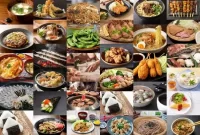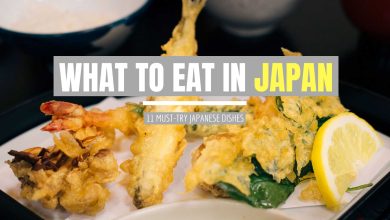What is the foods in Japan?
Variety, flavor, and artistic presentation are hallmarks of Japanese cuisine. It features a variety of foods, ingredients, and cooking methods. The following are some of the most well-known and typical dishes you can find in Japan:
Sushi: The most well-known Japanese food outside of Japan is sushi. Assorted components like fish, shellfish, vegetables, and even tropical fruits are often paired with vinegared rice. Sushi can be served as bowls (chirashi), rolls (maki), or individual pieces (nigiri).
Sashimi: Sashimi is raw fish or seafood that has been thinly sliced. Soy sauce, wasabi, and pickled ginger are occasionally added to the dish. Yellowtail, salmon, and tuna are common sashimi species.
Ramen: A popular noodle soup with Chinese origins that was modified and made even better in Japan is called ramen. It has savory broth and wheat noodles, and it frequently includes extras such sliced pork, boiled eggs, green onions, and seaweed.
Japanese dumplings known as gyoza are stuffed with a combination of ground meat (often chicken or pig) and veggies. They are frequently pan-fried and given with a dipping sauce.
Many people liken okonomiyaki to a Japanese pizza or a savory pancake. It is produced using a batter that includes flour, eggs, shredded cabbage, and various items like cheese, pork, or shellfish. A sweet and sour sauce is then drizzled on top.
Yakitori: Yakitori are grilled chicken pieces on skewers that are frequently seasoned with salt or a tasty sauce. The chicken’s breast, thigh, and liver are among the sections that can be found skewered and roasted.
Nigiri Tamago: A sweet, layered omelette is laid on top of a small bed of rice to create this particular style of sushi.
Fish that has been grilled and is frequently seasoned with salt or a sweet soy sauce is known as yakizakana. Salmon and mackerel are common kinds.
Miso Soup: Made from fermented soybean paste (miso), seaweed, tofu, and numerous other vegetables or ingredients, miso soup is a classic Japanese dish.
Onigiri: Onigiri are rice balls that are frequently rounded or formed into triangles and covered in seaweed. Typically, they have pickled plum, grilled salmon, or salted fish as their fillings.
Kaiseki: Kaiseki is a multi-course Japanese feast that features fresh, in-season, and locally sourced ingredients. It is frequently offered at upscale eateries and ryokan (traditional inns).
Japanese desserts: Sweets like mochi (crunchy rice cakes), dorayaki (pancake-like cakes filled with sweet red bean paste), and matcha-flavored candies are examples of Japanese desserts.
These are but a few illustrations of how varied and wonderful Japanese cuisine is. You may find distinctive and excellent foods all around Japan because the country’s culinary traditions differ from region to region. Dining in Japan is a joyful and culturally rich experience thanks to the emphasis on freshness, seasonality, and beauty in Japanese food culture.
Why is Japan famous for food?
For a variety of reasons, Japan is well-known for its cuisine, which has garnered praise and respect from all around the world. The following are some of the main causes of Japan’s reputation as a foodie:
Quality & Freshness: Using fresh, high-quality ingredients is very important in Japanese cuisine. The dedication to freshness means that flavors are at their finest in everything from seasonal vegetables to seafood caught the same day.
Prepared with skill: Japanese chefs are renowned for their commitment to accuracy and expertise. Many traditional Japanese foods call for careful preparation and presentation, and chefs may spend years honing their craft.
The most well-known Japanese meals, sushi and sashimi, are known across the world for their delicacy, elegance, and usage of raw fish. Particularly, sushi has gained popularity on a global scale.
Healthy Eating: Because it emphasizes balanced meals, lean proteins, and the use of fresh ingredients, Japanese food is frequently seen as a healthy option. This has boosted its appeal to people who are concerned about their health.
Food in Japan is strongly ingrained in the culture and customs of the nation. Many traditional practices and rituals are related to dining, which is frequently regarded as an art form.
Seasonal Variety: Japanese cuisine celebrates the passing of the seasons by incorporating particular ingredients and dishes into each one. This seasonal variety enriches and enlivens the cooking experience.
Wide Variety of Regional Specialties: Due to Japan’s diversified geography and climate, there are many different regional dishes. The richness of Japanese cuisine is enhanced by the distinct cuisines and flavors that are specific to each location.
Innovation: Whether it’s the blending of ancient and modern techniques or the invention of new cuisine trends, Japan is renowned for its culinary innovation. Japanese cuisine is always evolving, keeping it intriguing and new.
Street Food Culture: The diversity of delectable and practical snacks available in Japan’s street food culture, from yakitori (grilled skewers) to takoyaki (octopus balls), allows both locals and visitors to sample a wide range of tastes.
Overall, Japan’s dedication to culinary excellence, a deep respect for food, and a commitment to preserving culinary traditions while embracing innovation have all contributed to its status as a global culinary powerhouse.




